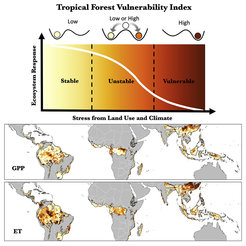Tropical rainforests respond differently to stressors
Tropical rainforests differ in their vulnerability to threats imposed by land use and climate change
New vulnerability index (TFVI) uncovers different sensitivities between humid tropical rainforests across the globe and provides early warning signals for regions undergoing critical transitions.
Humid tropical rain forests around the globe play a dominant role in the Earth system. They improve water filtration, provide biodiversity habitats and critically regulate the cycling of water and carbon. Rainforests are mostly endangered by a hotter and drier climate as well as by large-scale deforestation from wildfires and for agricultural and timber production.
Early warning by the index
The vulnerability of rainforests has in the past been measured with indicators from mostly local studies. In their novel approach, published in the journal One Earth recently, a large international researcher team now combined satellite data from the past decades, including climate and vegetation datasets, to analyze rainforest vulnerability on a global scale. With their unique tropical rainforest vulnerability indicator (TFVI), the researchers established a continuously updated tool to track the response of tropical rainforests to multiple stressors.

As first surprising results, it became evident that different tropical regions react differently to similar climate stressors, with some being more resilient than others. Also, rainforests at different continents differ in their sensitivity to climate and land use pressures. For example, the Amazon Basin shows particularly high vulnerability to both droughts and land-use change, when compared to the Congo Basin.
“The data from TFVI will provide a first and fast instance on risk and vulnerability, allowing us to further focus on key processes relevant for rainforest’s carbon storage and productivity, energy and water exchanges” says Dr. Nuno Carvalhais, coauthor and group leader at Max Planck Institute for Biogeochemistry in Jena, Germany. Such spatially explicit analyses will be crucial for identifying potential tipping points for each rainforest, which may occur as a gradual decline of ecosystem services or as an abrupt change. By tracking the rainforest responses to stressors, the TFVI index can provide early warning signals for threatened regions, in order to stimulate measures aimed at increasing resilience and climate mitigation.












